How to choose an automatic pumping station for a water supply system
A pumping station is a popular version of equipment for organizing autonomous water supply for a private house. These are reliable and relatively compact devices that can provide high-quality water delivery to all points of consumption.
The equipment is not cheap, so before buying it is necessary to weigh the pros and cons, study the characteristics and compare them with the upcoming operating conditions. Agree, at first glance, the task seems quite complicated.
We will show you how to choose a pumping station, describe the device and the principle of operation of the equipment, and also outline the main criteria for a competent purchase. In addition, we compiled an overview of popular brands whose products have won the trust of users. The information in the article will help you make the right choice.
The content of the article:
How does a pumping station work?
A pumping station is a complex of devices consisting of a pump, storage tank with rubber or membrane insert, pressure switch and control panel.
The principle of operation of the station is quite simple. The pump pumps water into the hydraulic tank, here the water is under a certain pressure, which depends on its quantity and the volume of air in the tank. As water is consumed, the pressure in the accumulator decreases.
Configured accordingly pressure switch captures the change in the amount of water. Upon reaching the minimum settings, the relay switches on the pump so that the hydraulic tank is filled with water. As the tank fills, the pressure increases, the relay fixes its maximum level and turns off the pump.
The on and off cycle is repeated in such a way that the amount of water in the tank is constantly available that can meet the needs of the residents of the house.
Such a system is highly efficient. For example, if the water supply was connected directly to the pump, the equipment would have to be turned on every time someone opened the tap.
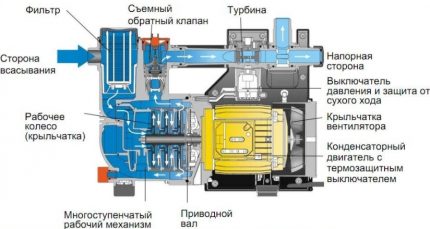
The presence of a pumping station with a hydraulic tank allows you to reduce the number of on / off pump to the required minimum. This significantly saves the life of the equipment, extends its service life. Since the water in the hydraulic tank is under pressure, a good pressure can be created in the entire water supply system of the house.
An acceptable indicator is usually about 1.5 atm, but it can be increased if necessary. Separate household appliances (washing machines and dishwashers, Jacuzzi bathtubs, showers with hydromassage) in the absence of sufficient pressure in the water system just can't work.
The pump station effectively solves this problem.
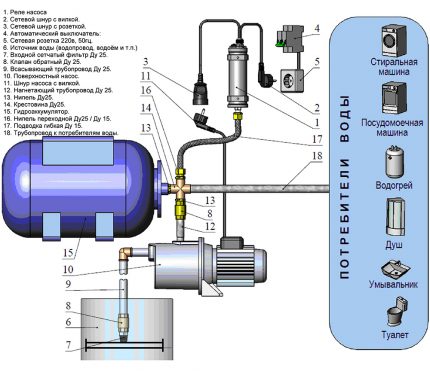
If, for some reason, access to water is limited or absent (breakdown of the pump, a sharp decrease in the flow rate of the well, etc.), the supply of water in the hydraulic tank will be very useful.
Water can be used for some time until access to water resources is restored. If a pump is used instead of a station, turning it off automatically deprives water of all residents of the house.
Features of installation and operation
The pump station can be assembled independently, but it is easier to buy a ready-made unit. These devices are relatively simple in installation and operation.
To install the station you will need a flat area and shelter from the weather. The hose of the surface pump is lowered into the well or well, the hydraulic tank is connected to the water supply system of the house, and I provide the entire system with power (need RCD).
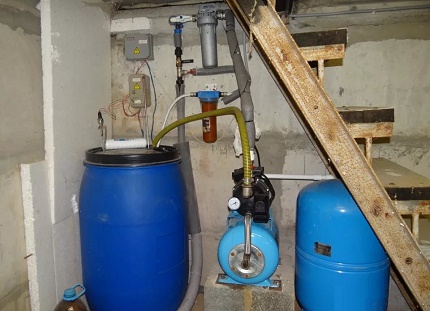
After that remains set pressure switch and start operating the station. Further intervention in the operation of the device is usually not required.
The station will replenish the supply of water in the hydraulic tank in automatic mode. It is recommended that approximately every three months, the operation of all elements of the pumping station be checked. As necessary, carry out maintenance of individual components: flushing the pump, adjusting the pressure switch, replacing the membrane in the hydraulic tank, etc.
If the pumping station is selected and installed correctly, it can work for many years without interruption.
The problem of choosing a pumping station
Such equipment is offered to the consumer in a very wide range.
Models of modern pumping stations differ in a whole set of parameters, such as:
- price;
- equipment;
- place of manufacture;
- brand name
- performance;
- accumulator volume;
- power consumption;
- design features;
- equipment, etc.
At choosing a specific model the pumping station should first carefully study the conditions of its operation. If a well serves as a source of water intake, you should carefully study the construction passport, it contains a lot of useful information.
If there is no special technical documentation, you will have to find out the characteristics of the well yourself.
Here is a list of indicators that you should focus on when choosing a pumping station:
- well / well flow rate, i.e. amount of water delivered per unit of time;
- statistical and dynamic water level in the well;
- the height at which water will have to be supplied;
- distance from the source of water to its place of consumption.
Productivity is one of the main indicators when choosing a pumping station. It characterizes the maximum amount of water that can be delivered to a house in a certain period of time.
First you need to calculate exactly how much water will be needed. At the same time, the number of people permanently residing in the house is taken into account, as well as the presence and characteristics of household appliances that use water: a washing machine, bathtub, hydromassage, etc.
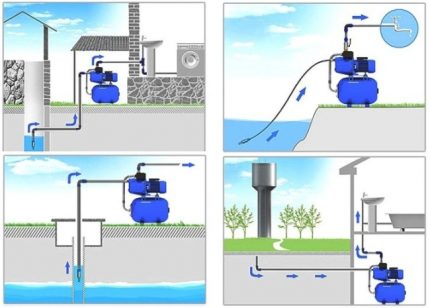
In this case, the parameters of the pumping station should be correlated with data on the flow rate of the well or well. Problems may arise if water is taken from the source more intensively than natural replenishment. In such a situation, it is likely that one day the well or well will be empty.
And this will lead to the equipment in dry running mode. Therefore, if the performance of the pumping station significantly exceeds the flow rate of the structure available on the site, it is worth looking for a more suitable model.
Typically, for the organization of autonomous water supply in a private house, pumping stations are selected, the power of which varies between 3-6 thousand l / h.
To roughly imagine the necessary equipment performance, you can focus on the following information:
- Peak water consumption at the summer cottage is usually about 0.8-1.5 cubic meters. m / h
- A family of 4-6 people living in a medium-sized cottage consumes about 1.5-2 cubic meters. m / hour.
- For a large country house, taking into account the need for watering, maintenance of the pool, fountains, etc. the need for water will be at least 3-4 cubic meters. m / h
The power of the pumping equipment can be 0.6-1.5 kW.Here, not only the amount of water that needs to be pumped into the house is important, but also the distance from the point of water intake to the point of its consumption, as well as the height that the water column will have to overcome in order to get into the house.
The more these indicators, the more powerful equipment should be chosen.
The depth at which water has to be taken can be of decisive importance. Usually pumping stations are equipped with surface self priming pump, which is effective at a depth of 6-8 m. Owners of deeper wells, as a rule, should use more powerful submersible pumps.
You can solve the problem using a self-priming pump with remote ejector. This is a more complex device, but it allows you to increase the depth of water intake to 30 meters and even more. Moreover, such equipment can be used in standard four-inch wells.
Of course, the dimensions of the hydraulic accumulator tank deserve attention. You should not choose a container that is too large in volume, since it will gain significant physical weight when filled with water. Hydraulic tanks are usually made of stainless steel, as well as cast iron or plastic.

For long-term use, taking a plastic container does not make sense, it has a too short life. Cast iron tanks are exceptionally reliable, but have a high cost. Light, relatively inexpensive and durable steel is used for the manufacture of hydraulic tanks most often.
The inner liner made of rubber may have a pear shape or be made in the form of a membrane. Since this element experiences a constant and at the same time changing load, it may fail over time. When choosing a pumping station, it makes sense to think about the possibility of replacing the tank liner.
The cost of the pumping station can be significantly affected by the presence of protective modules. This equipment allows you to automatically turn off the pump, if the source has run out of water. If you do not turn off the equipment on time, working in idle mode will cause the engine to overheat, resulting in significant damage.
In some cases, it is necessary to completely replace the engine, pump or the entire station. Is it worth it to spend money on a pumping station with an automatic control unit? On the one hand, this is a very convenient module, on the other - additional expenses.
In almost all cases, automation is an appropriate acquisition, especially when it comes to supplying a large house with water for a whole year. Manual control of a pumping station should be considered only if it is purchased for a small cottage where such equipment is used irregularly.
Recommendations for the selection of equipment
Pumping station - equipment is not cheap. When choosing a suitable model, it makes sense to pay attention to the products of well-known brands with a good reputation.
Too low a price is not the best indicator for a pumping station. Typically, such units have quality problems that will appear only during operation.
The most important point is after-sales service and warranty. The product must be equipped not only with a technical passport and detailed instructions, but also with properly executed warranty documents, which should be carefully studied.
The long warranty period of an automatic pumping station usually indicates its high quality. You should also familiarize yourself with the procedure for providing warranty services.
It happens that for pump station repair under warranty, you have to go to the nearest city, region or even send broken equipment to a neighboring country, and this is long and extremely inconvenient.
At the end of the warranty period, repairs and maintenance will have to be done independently. You need to make sure that the materials, spare parts and components necessary for this are on sale, so that you do not have to wait for months to deliver the item you need to repair the station.
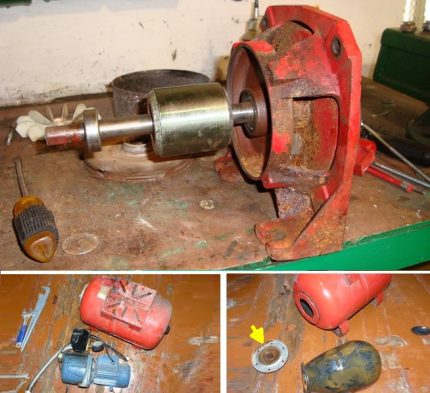
Usually there are no big problems with pumping stations of well-known foreign companies, since they have not only a wide dealer network, but also an established system of after-sales service for their products.
It is worth paying attention to domestic products, which with high quality can offer more attractive prices for pumping stations.
Recommended Models
Marina APM 100/25
This is a fairly powerful Italian-made pumping station with a sturdy cast-iron housing. It is designed to pump clean water.
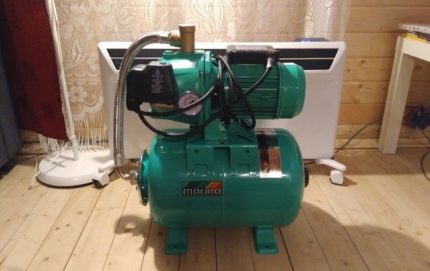
The power consumption of the equipment is 1.1 kW, the capacity is 2400 l / h, the available immersion depth is 25 m. Such a pump station is perfect for servicing a relatively large cottage.
Grundfos Hydrojet JPB 6/24
The pumping station from a well-known Italian brand, consumes 1,400 watts of electricity, while it allows you to get about 5 cubic meters. m of water per hour.
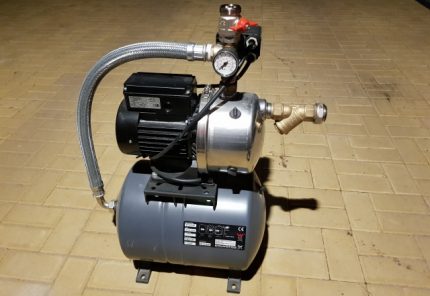
The immersion depth of this device is relatively small - only 8 m. It is designed for operation in moderate latitudes and is of high quality, however, like all products with the GRUNDFOS logo. Suitable for giving or a small cottage.
Gardena 4000/5 Classic
This unit consumes a little - only 0.85 kW with a quite impressive performance, which is about 3500 l / h.
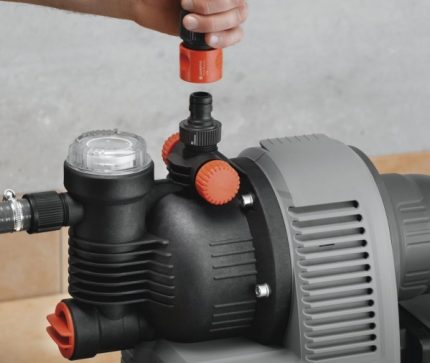
This is a universal version of the pumping station, which can be used for the needs of the house and the surrounding area. Use such equipment even for maintenance of water supply nodes.
Jumbo 50/28 H-24 and Jumbo 70/50 H-50 N HOUSE
Jumbo Jilex pumping stations are very diverse. The performance of these devices, immersion depth and power vary over a fairly wide range, which allows you to choose a model that is ideal for specific conditions.
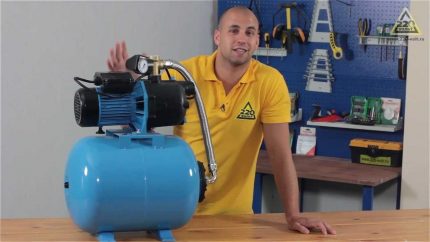
For instance, Jumbo 50/28 H-18 with a capacity of about 3 m³ / h is suitable for a small cottage.
And here Jumbo 70/50 N-50 N HOUSE Can be used in a medium sized cottage. Some models are additionally equipped with an ejector, which can significantly increase the depth of immersion. The cost of pumping stations of this manufacturer is relatively low, while the reviews on the quality of the products are mostly positive.
AQUAROBOT M
This is a series of water pumping stations designed specifically for low debit water sources. Such models are relatively inexpensive, the power of the pumping station is less than 250 watts. Such a unit can be an excellent choice for a summer house or a small house.
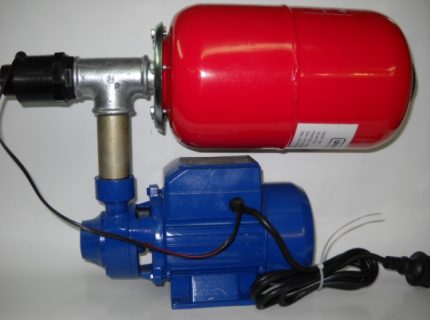
AL-KO HW 4000 FCS Comfort
This is the ideal solution for deep wells. For wells, this compact model can also be safely used. A power of 1000 W allows you to lift water from a depth of 45 m. The maximum capacity is 4 m³ / h.
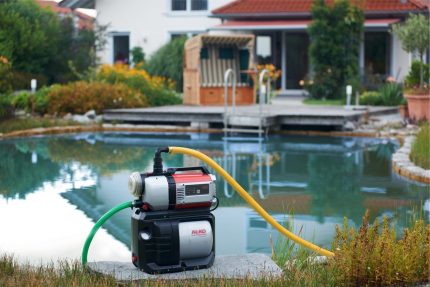
Such pumping stations will provide the necessary pressure in the house, as well as carry out watering work on the site.
Wilo Jet HWJ 203 50L
This is a pump station with an open tank. With a power of 1000 W, it can be used to draw water from a depth of 42 m. Productivity at the peak will be 5 m³ / h.
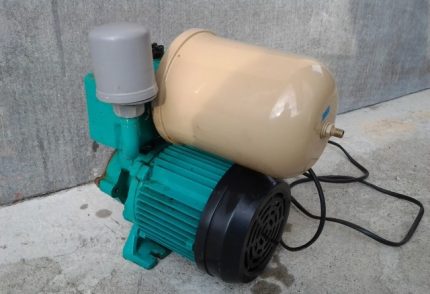
All units manufactured under the Wilo brand are highly reliable. This type of equipment is designed to operate in harsh climates.
Whirlwind ACB-800/24
It is a small pumping station, popular in dachas and in private houses, but equipped with a spacious hydraulic tank. The maximum immersion depth is 9 m, power - 800 W, productivity - 3.6 m³ / h, average price range. All this made the Whirlwind pumping stations extremely popular.
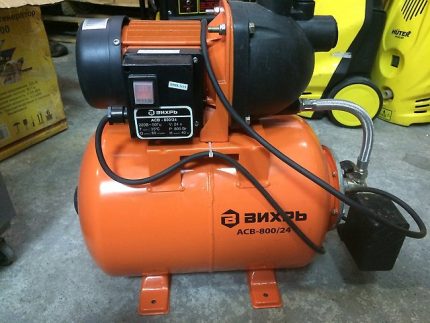
It is worth noting that this equipment is suitable for use in hot climates, since it works without interruption even at 50 degrees of heat.
Belamos XK 08 ALL
This is a pumping station manufactured in Belarus - has similar characteristics and is in the same price category. With a power of 800 W, it provides a capacity of about 3 m³ of water per hour.
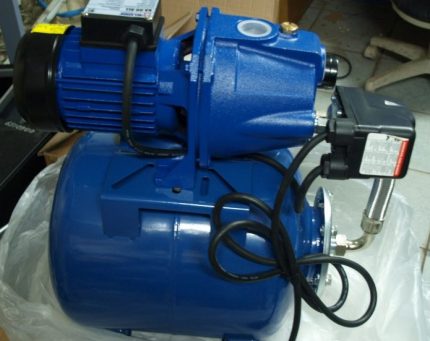
This pumping station can be used both with a well or a well, and when connected to a main water supply. In any case, it will provide the necessary pressure of water.
Recommendations for choosing a pumping station for summer cottages are given in this article, and for a private house - here.
Conclusions and useful video on the topic
Here you can see an overview of various models of pumping stations:
This video contains useful recommendations for choosing a pumping station, taking into account operating conditions:
If the equipment is chosen correctly, it will work for a long time and without breakdowns. A pump station is a great way to provide sufficient pressure in the water system of a house to make it truly comfortable.
Looking for an efficient and inexpensive pumping station? Or have experience using such installations? Please leave comments on the article and share your impressions of the use of pumping stations.

 Pumping station without accumulator: operation features and water supply devices without hydraulic tank
Pumping station without accumulator: operation features and water supply devices without hydraulic tank 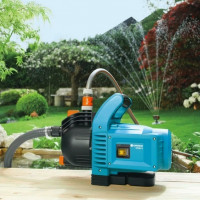 The best surface pumps: we choose pumping equipment for home and country communications
The best surface pumps: we choose pumping equipment for home and country communications 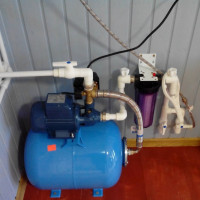 Connecting a pumping station to a well: rules for organizing autonomous water supply
Connecting a pumping station to a well: rules for organizing autonomous water supply 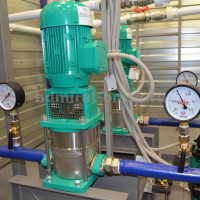 Principle of operation and design of a typical pumping station for water supply
Principle of operation and design of a typical pumping station for water supply 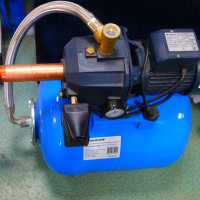 Pumping stations for wells: how to choose, features of connection and installation
Pumping stations for wells: how to choose, features of connection and installation 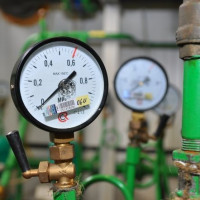 Pressure in the water supply system of a private house: the specifics of autonomous systems + ways to normalize pressure
Pressure in the water supply system of a private house: the specifics of autonomous systems + ways to normalize pressure  How much does it cost to connect gas to a private house: the price of organizing gas supply
How much does it cost to connect gas to a private house: the price of organizing gas supply  The best washing machines with dryer: model rating and customer tips
The best washing machines with dryer: model rating and customer tips  What is the color temperature of light and the nuances of choosing the temperature of the lamps to suit your needs
What is the color temperature of light and the nuances of choosing the temperature of the lamps to suit your needs  Replacement of a geyser in an apartment: replacement paperwork + basic norms and requirements
Replacement of a geyser in an apartment: replacement paperwork + basic norms and requirements
BELAMOS XK - what kind of performance is about 6L of water per hour ???
The author was mistaken, apparently. At 800 watts, these pumps deliver approximately 3,000 l / h. with a pressure of 30 m and a suction height of up to 8 meters.
Most likely, this refers to the Belamos XK 08 surface self-priming pump. This is a domestic pump. I do not know how the surface options work, but the submersible options from this company are very reliable.
The article made a typo. And now I looked at the characteristics, there the performance indicator is 3m cubic per hour, and the article says 3.6. Corrected.
I haven’t heard anything bad from people who use Belamos pumps. I have had a submersible version for two years in the country, no complaints, it works like a Swiss watch. By the way, Belamos XK 08 may be needed in the near future, then I'll unsubscribe how it works.